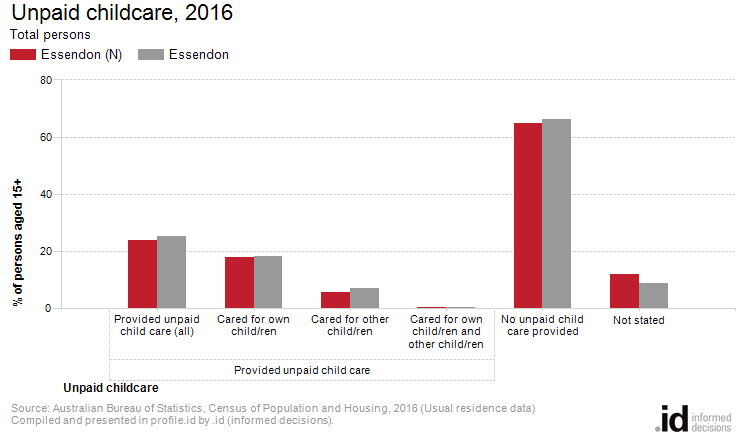Essendon (N)
Unpaid childcare
In Essendon (N) 607 people (23.6% of people aged 15+) provided unpaid care to children in 2016. Of these, 150 people were caring for children other than their own.
The role of unpaid childcare in Essendon (N) is determined by many different factors. For example areas with high levels of unpaid child care may have a dominance of single income families with one significant earner, or there could be a lack of provision of paid child care in the area. The level to which people care for others children can also indicate the role of extended family (eg. grandparents caring for grandchildren, family day care).
The role of unpaid child care is a complex one so this topic should be viewed in conjunction with several others, including Household Type, Employment, Household Income and Educational Attendance.
Derived from the Census question:
'In the last two weeks did the person spend time looking after a child, without pay?', which specifically asks respondents to differentiate between caring for their own children and caring for others children.
Persons aged 15 years and over.
Source: Australian Bureau of Statistics, Census of Population and Housing (opens a new window) 2011 and 2016. Compiled and presented by .id (opens a new window)(informed decisions).

Compiled and presented in profile.id by .id (informed decisions).

Compiled and presented in profile.id by .id (informed decisions).
Dominant groups
Analysis of the unpaid child care provided by the population in Essendon (N) in 2016 compared to Essendon shows that there was a lower proportion of people who provided unpaid child care either to their own or to other children. Overall, 23.6% of the population provided unpaid child care, compared with 25.1% for Essendon.
The major differences between the share of the population providing unpaid child care in Essendon (N) and Essendon were:
- A smaller percentage who did not provide care for children (64.7% compared to 66.3%)
- A smaller percentage who provided unpaid childcare for other child/ren (5.7% compared to 7.0%)
Emerging groups
The number of people who provided unpaid child care for their own and/or other people's children in Essendon (N) increased by 151 between 2011 and 2016.
The largest changes in the number of people performing unpaid child care in Essendon (N), between 2011 and 2016 were those who:
- Provided no unpaid child care (+415 persons)
- Cared for their own child/ren (+116 persons)
